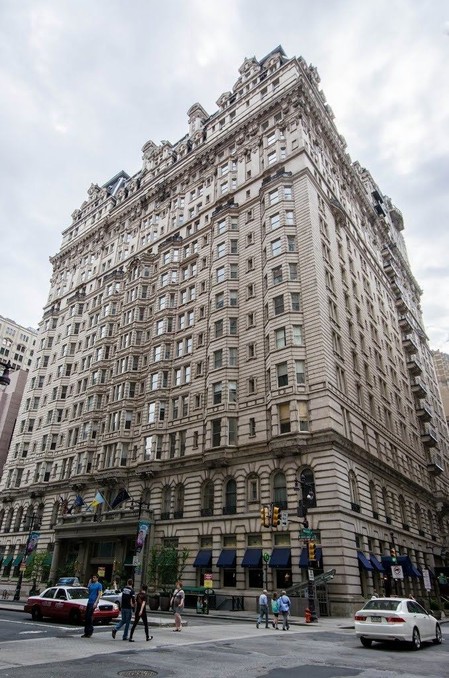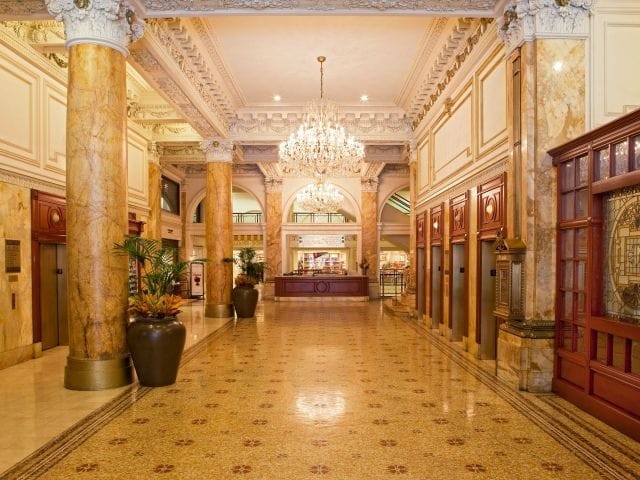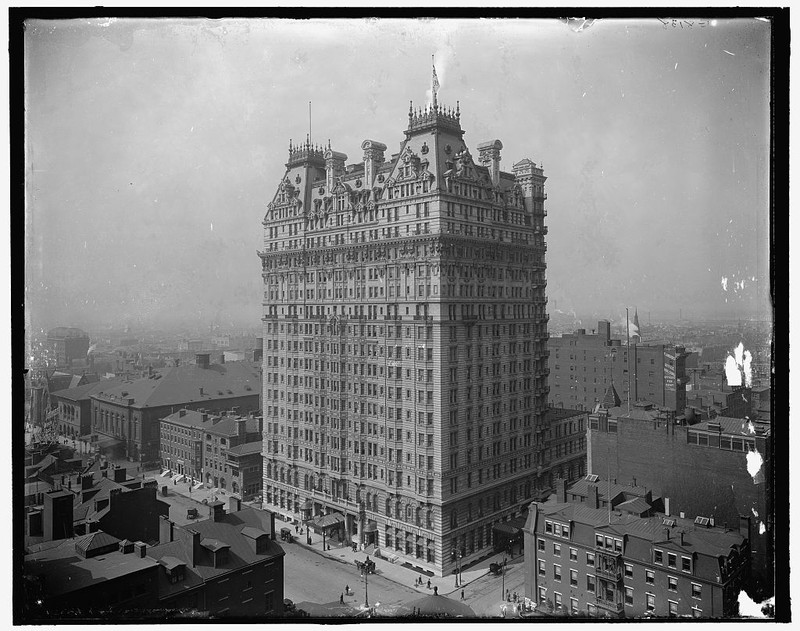Bellevue Stratford Hotel (now the Bellevue Philadelphia)
Introduction
Text-to-speech Audio
Known as the "Grand Dame of Broad Street" in its early years, the Bellevue Stratford Hotel opened its doors in 1904. The Bellevue was described at the time as the most luxurious hotel in the country at that time, and a stay at the Bellevue Stratford was considered the height of opulence. The property was famous for its lavish ballroom and light fixtures designed by Thomas Edison. The hotel also has the sad distinction of being the site of the first known outbreak of Legionnaire's Disease when attendees of an American Legion attended a convention at the hotel in 1976. The Bellevue Stratford is listed on the National Register of Historic Places.
Images
The Bellevue

The hotel's lobby

The hotel in the early 1900s

The hotel's ballroom

Backstory and Context
Text-to-speech Audio
The Bellevue Stratford Hotel opened in 1904 after two years of construction. The property was built by George C. Boldt, who was once manager of the Waldorf-Astoria in New York City. The nineteen story, French Renaissance structure was designed by architects G. W. and W.D. Hewitt and featured virtually every luxury amenity available in the early twentieth century. The hotel was famous for its lavish ballroom and its light fixtures designed by Thomas Edison, which are still in the hotel today.
For decades, the hotel was one of the most famous in the United States. It hosted numerous Hollywood celebrities and political dignitaries, including J. P. Morgan, Katherine Hepburn, John Wayne, William Jennings Bryan, and the Vanderbilt family. The hotel has also hosted every US President since Theodore Roosevelt.
The late twentieth century would not be so kind to the Bellevue Stratford, however. In July of 1976, the hotel hosted thousands of members of the American Legion for their annual convention. When the attendees returned home, many began developing strange symptoms and complained of tiredness and chest pains. Many people feared an outbreak of swine flu or a return of the deadly flu epidemic that killed millions in 1919. After CDC investigators were brought in, it became apparent that whatever the disease was, the Bellevue Stratford was at its epicenter.
Ultimately, 182 people who stayed at the hotel in late July of that year became sick, and of those, 29 died. The culprit was eventually identified--a previously unknown bacteria that scientists named Legionella pneumophila---or Legionnaire's Disease, likely carried by the hotel's cooling system. The hotel was forced to close following weeks of plummeting reservations. The hotel was eventually sold in 1978 and completely renovated, including the installation of a new heating and cooling system.
The hotel's revitalization helped spur the revitalization of Broad Street. Today, the historic property is owned by Hyatt followed extensive renovation and modernization. The building was added to the National Register of Historic Places in 1977 and is once again considered one of the finest places to stay in Philadelphia.
For decades, the hotel was one of the most famous in the United States. It hosted numerous Hollywood celebrities and political dignitaries, including J. P. Morgan, Katherine Hepburn, John Wayne, William Jennings Bryan, and the Vanderbilt family. The hotel has also hosted every US President since Theodore Roosevelt.
The late twentieth century would not be so kind to the Bellevue Stratford, however. In July of 1976, the hotel hosted thousands of members of the American Legion for their annual convention. When the attendees returned home, many began developing strange symptoms and complained of tiredness and chest pains. Many people feared an outbreak of swine flu or a return of the deadly flu epidemic that killed millions in 1919. After CDC investigators were brought in, it became apparent that whatever the disease was, the Bellevue Stratford was at its epicenter.
Ultimately, 182 people who stayed at the hotel in late July of that year became sick, and of those, 29 died. The culprit was eventually identified--a previously unknown bacteria that scientists named Legionella pneumophila---or Legionnaire's Disease, likely carried by the hotel's cooling system. The hotel was forced to close following weeks of plummeting reservations. The hotel was eventually sold in 1978 and completely renovated, including the installation of a new heating and cooling system.
The hotel's revitalization helped spur the revitalization of Broad Street. Today, the historic property is owned by Hyatt followed extensive renovation and modernization. The building was added to the National Register of Historic Places in 1977 and is once again considered one of the finest places to stay in Philadelphia.
Sources
The Grand Dame of Broad Street. 99percentinvisible.org. . Accessed March 17, 2019. https://99percentinvisible.org/episode/the-grand-dame-of-broad-street/.
About Us. bellevuephiladelphia.com. . Accessed March 17, 2019. https://www.bellevuephiladelphia.com/about.php.
Markel, Howard. How a Hotel Convention Became Ground Zero for this Deadly Bacteria. pbs.org. July 23, 2018. Accessed March 17, 2019. https://www.pbs.org/newshour/health/how-a-hotel-convention-became-ground-zero-for-this-deadly-bacteria.
About Us. bellevuephiladelphia.com. . Accessed March 17, 2019. https://www.bellevuephiladelphia.com/about.php.
Markel, Howard. How a Hotel Convention Became Ground Zero for this Deadly Bacteria. pbs.org. July 23, 2018. Accessed March 17, 2019. https://www.pbs.org/newshour/health/how-a-hotel-convention-became-ground-zero-for-this-deadly-bacteria.
